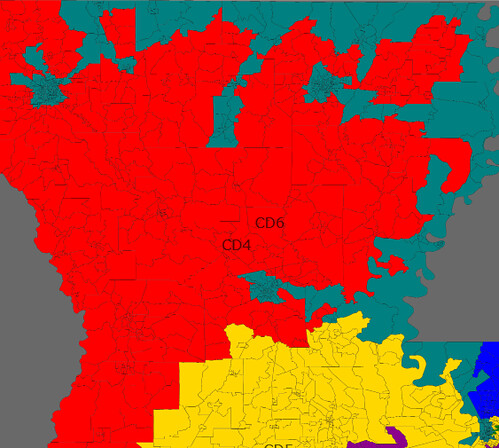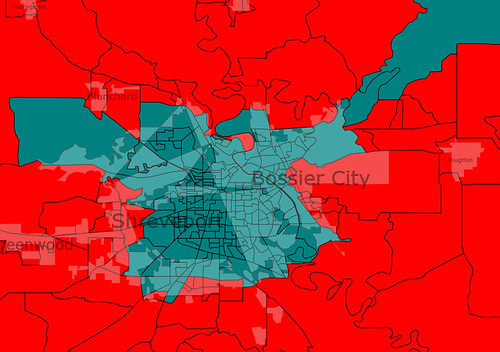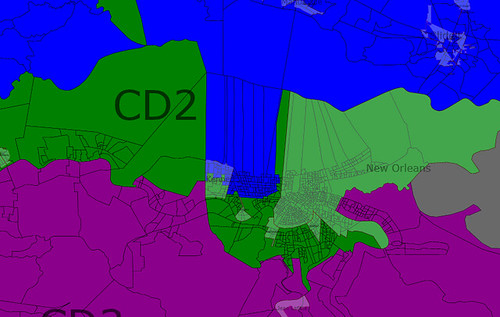Episode 5 in my redistricting series, and as you can see, I’m picking up the pace, having just covered Georgia and New Jersey yesterday. Because the Census released 2008 county estimates last week, I feel like knocking out these diaries for the states I already mapped using 2007 numbers. Of course, because they’re 2007 numbers, they’re not quite up to snuff, but in most cases, the lines wouldn’t look too dramatically different using newer stats.
Previously covered:
Diary 1: Massachusetts and Texas
Diary 2: Michigan and Nevada
Diary 3: Iowa and Ohio
Diary 4: Georgia and New Jersey
Geek out below!
Florida
Now, this is the single hardest state I had to tackle. More so than Texas, more so than Ohio, more so than Pennsylvania. That’s because Florida is perhaps the most masterful Republican gerrymander in the nation; a state that voted 51% to 48% for President Obama is represented in Congress by 15 Republicans and 10 Democrats, and before 2006, the skew was 18-7. Considering Democratic dominance in South Florida and clear Dem trends along I-4, that’s pretty astounding cartographic craftiness by the GOP.
Unfortunately, unless we pick up the governor’s mansion in 2010 (virtually impossible, IMHO, unless Crist runs for the Senate, and even then, the GOP bench in Florida is quite deep), Republicans are set for another round of redistricting monopoly in 2011-12 (one caveat: a nonpartisan commission initiative is on the ballot in 2010, but since it needs 60% to pass, I’m skeptical). While Republicans’ room for growth is limited, what with Dem trends in Central FL and the Cuban districts softening, there could be at least one Dem casualty along with a new GOP seat, for a 17-9 delegation, though 16-10 would be a lot easier for legislators to ensure, since it’s not exactly a cinch to dismantle a moderate I-4 Dem like Suzanne Kosmas. Note: there is an outside chance that Florida will pick up two seats in reapportionment, but the disastrous real estate market has brought that long-famed migration to the Sunshine State to a grinding halt. In 2008, even recession-battered California grew faster. So I’m betting on a one-seat gain; the explosive growth in Florida between 2000 and 2006 more or less ensures at least that one gain, but I can’t envision a sufficiently large uptick in growth between now and the Census for a 27th District.
To sum it up, I’m actually not very satisfied with this map. It’s revoltingly gerrymandered, though no worse than the current iteration, and I’m not sure about some of my boundaries (is Alcee Hastings’ 23rd still VRA black-majority with these lines?). But I tried to maintain the best possible lines for the Republicans (i.e. mostly the status quo), with an emphasis on incumbent protection. I may have done things a bit differently if I’d used 2008 numbers, so an eventual do-over on my part isn’t out of the question.
To the point: the GOP has a real problem along I-4: with Orange and Osceola Counties decidedly Democratic, and Adam Putnam’s soon-to-be-open seat a near-tie between McCain and Obama, they can only play offense so much. I figured that since Orlando is becoming so progressive, they would concede Alan Grayson’s seat (assuming he is reelected in 2010) and hurt Kosmas only by roughly maintaining the current, Feeney-drawn lines. Meanwhile, FL-12 (Putnam) is shored up by moving into some hardcore Republican territory, and a new 26th District is created from Central Florida leftovers (unfortunately for them, it only barely leans Republican in a neutral year as I’ve drawn it, and in a year like 2006 or 2008, might well elect a Democrat). Again, I tried my best to be devious, but when a state is already so gerrymandered for one party and the trends are running against that party in key regions of said state, “safety first” is the likely tack.
As for South Florida, my boundaries are imprecise, so the summary descriptions are a bit more informative. Basically, I tried to replicate the current boundaries in most of these cases, while cleaning up the 23rd (as I mentioned, though, it probably can’t be as cleaned-up as I drew it since it is a VRA seat). If more specific Census estimates were available, I could have known how to, for example, boost the Cuban-American percentage in Districts 18, 21, and 25, but instead, I was left with a sloppy, low-tech method as the Miami metro area goes.
For now, this is the map I’ve got:

Ugly? You bet. Want a logical map? The Sunshine State GOP wouldn’t hear of it.
District 1 – Jeff Miller (R-Chumuckla) — contracts in area; still the most conservative district in the state.
District 2 – Allen Boyd (D-Monticello) — still an old-school district of Jimmy Carter white Democrats who vote GOP for President. When Boyd retires, we will be in trouble here, as even the boosted black turnout of 2008 only resulted in a 54-45 McCain victory.
District 3 – Corrine Brown (D-Jacksonville) — well, it’s not quite as grossly drawn as before, but it must remain a VRA African-American seat, so I had to get creative.
District 4 – Ander Crenshaw (R-Jacksonville) — random trivia: did you know there were Civil War battles in this district?
District 5 – Ginny Brown-Waite (R-Brooksville) — I tried to clean up this and the 6th, both previously with needlessly messy lines; this one stays safely Republican, but now only splits one county (Pasco).
District 6 – Cliff Stearns (R-Ocala) — stays heavily Republican but looks a bit more aesthetic. No, I don’t like Gainesville being represented by a Republican any more than you do, but it is a blue island in a sea of red (much like Athens, Georgia).
District 7 – John Mica (R-Winter Park) — by only encroaching a bit into Orange County and making St. Johns County the largest population source, I attempted to help Mica, but the long-term trends here are not advantageous to him. If he moved out of Orange County, he could be drawn a safer seat.
District 8 – Alan Grayson (D-Orlando) — entirely within Orange County, meant to soak up Democrats to allow for a Republican 26th and to prevent Kosmas from getting too comfortable. I think if there’s one painful concession the GOP will have to make, this is it.
District 9 – Gus Bilirakis (R-Palm Harbor) — jumps around north Tampa Bay looking for Republicans, doesn’t change too much.
District 10 – Bill Young (R-Indian Shores) — entirely within Pinellas, probably still a 50/50 district. This is a seat they may well lose when Young calls it quits. With both A) the need to protect Bilirakis, and B) Castor’s 11th being maxed-out on Democrats, it’s another uncomfortable decision for the Republicans not to shore this district up very much. As long as the aging Young stays on the ballot, they don’t have to worry.
District 11 – Kathy Castor (D-Tampa) — still the bay-dancing Tampa-St. Petersburg seat, concentrating Democrats and with a significant black minority.
District 12 – Adam Putnam (R-Bartow) — since McCain won here by a mere inch, and Putnam is leaving in 2010, I figured protecting the 12th for future elections will be a major priority (if a Dem wins in 2010, the GOP will seek to dismantle that person before targeting Grayson or Kosmas). So, even as slightly GOP-leaning Polk County dominates my 12th, Sumter, Hardee, and DeSoto put it over the edge to produce a McCain victory of at least 53-46.
District 13 – Vern Buchanan (R-Sarasota) — this is only a tad more Republican than before, with the whole inclusion of Manatee County aiding GOP numbers.
District 14 – Connie Mack (R-Fort Myers) — dominated by Lee County with remainders of Sarasota and Charlotte. Still the quintessential Gulf Coast GOP mecca.
District 15 – Bill Posey (R-Rockledge) — in retrospect, I’d do this differently, as this is one district the GOP would probably weaken a bit to harm Kosmas or solidify the new 26th.
District 16 – Tom Rooney (R-Tequesta) — stretches from Charlotte to Palm Beach, much like before. If Rooney is easily reelected in 2010, he will be another incumbent they loosen up to cement weaker districts.
District 17 – Kendrick Meek (D-Miami) — should stay the most heavily black, most overwhelmingly Democratic district in the state.
District 18 – Ileana Ros-Lehtinen (R-Miami) — while Ros-Lehtinen can probably hold on quite a few more cycles, this is the only GOP district other than Bill Young’s 10th that voted for Obama, and as Miami Hispanics trend toward the Democrats, all three Cuban-American Republican seats will be endangered. What happens when Ros-Lehtinen and/or the Diaz-Balarts retire? I’m not exactly sure how to solidify these three seats, as the nearest turf they could grab is mostly liberal-leaning anyway. Perhaps they could snag some Gulf Coast Republicans, but that would dilute the VRA Hispanic percentages…
District 19 – Robert Wexler (D-Boca Raton) — the most liberal of the three “Jewish districts” (I say that, of course, tongue firmly in cheek, as the Jewish percentage is a distinct minority in all three seats).
District 20 – Debbie Wasserman Schultz (D-Weston) — the second of the three, nearly as Democratic as the 19th.
District 21 – Lincoln Diaz-Balart (R-Miami) — as with Ros-Lehtinen and the 18th, I don’t know how to shore up the three traditionally GOP Cuban seats.
District 22 – Ron Klein (D-Boca Raton) — still a coastal stretch; I think the GOP won’t change the lines much here, unless they can find a way to pack Democrats here who would otherwise be left in the 18th, 21st, or 25th.
District 23 – Alcee Hastings (D-Miramar) — regardless of how my lines appear, Hastings’ seat will stay majority-black under the VRA.
District 24 – Suzanne Kosmas (D-New Smyrna Beach) — the closest I could come to targeting Kosmas was to only take in 10% of Orange County, along with 64% of GOP-leaning Seminole and 67% of narrowly Dem-leaning Volusia. Once again, Republican gerrymandering in Central Florida can’t possibly get much more aggressive without sacrificing a couple seats.
District 25 – Mario Diaz-Balart (R-Miami) — see the 18th and 21st.
New District 26 – Central FL, Leans Republican — Osceola and St. Lucie Counties favor Democrats, so it is no accident that I made the largest pop. source here 56% McCain-supporting Lake County, cutting through heavily GOP Okeechobee. Due to the inclusion of Osceola, there will be a significant Hispanic minority here, and a Dem base vote of about 46-47%, rendering it vulnerable to a future loss. Is there a way to draw this that is better for the Republicans? Probably, and I’m sure their computers will find it…but Putnam, Posey, Rooney, Bilirakis, Brown-Waite, and Stearns all need to be protected at the same time. The balance along I-4 really is that tenuous for them.
Overall, my map is flawed, as is the current map in Florida. I intended for realism’s sake to create a masterful Republican gerrymander and ended up with a plan that would, at best, maintain the status quo with a 16-10 GOP edge (with the best possible scenario being an eventual 18-8 if Boyd retires, Kosmas is defeated, and every Republican seat stays intact…quite a tall order indeed). Unless Central FL swings decisively to the Republicans in 2010, there is minimal room for offense on their part…and how to stave off Dem advances in Miami-Dade? In the end, to everyone’s surprise, the biggest winners from the next map may be incumbent Democrats like Klein, Grayson, and Kosmas who picked up seats drawn to reelect Republicans. It really is in the GOP’s interest to salvage what they have in Florida rather than get too greedy.
Louisiana
This was a lot easier, though not exceedingly comforting for a Democrat. The severe population loss in the New Orleans area means that there may no longer be a strong Dem seat in Louisiana, let alone a VRA district. No doubt my proposed District 2 would retain a large black percentage, but I’m far from certain it would be anything near a majority. Might the same judicial system that once rejected Cleo Fields’ “Z district” as a racial gerrymander change its tune in the name of the Voting Rights Act?
As for the political dynamics in Louisiana, Jindal will still be Governor at least through 2011, when redistricting starts, and the legislature is perilously close to flipping to the GOP (the House is already run by a de facto GOP-friendly coalition, with a Republican Speaker to boot). Even if the Senate remains in Democratic hands, Louisiana Dems aren’t exactly known for their party loyalty.
But the task here is simple, and Democratic strength in the Pelican State has collapsed so rapidly that partisan considerations aren’t nearly as influential as they would seem. Everyone agrees that a New Orleans-area seat has to be eliminated, so here’s roughly what I imagine the somewhat Republican-esque legislature coming up with:

Note: Technically, Charlie Melancon’s home was put in the 1st for population reasons, but I would expect him to run in the 2nd instead.
District 1 – Steve Scalise (R-Jefferson) — had to expand in land, but stays heavily Republican.
District 2 – tentatively, Joseph Cao (R-New Orleans) vs. Charlie Melancon (D-Napoleonville) — Melancon would do well to move here, as the boundaries do vaguely resemble his old 3rd, but since the bulk of district population is in Jefferson and Orleans Parishes, it’s his seat that was cracked and eliminated. A New Orleans pol would be favored geographically, and I’m not sure what the political leanings would be here (my guess is competitive, with Dem strength in New Orleans offset by GOP dominance in Jefferson Parish). This might make a worthy court challenge, depending what the race stats are here (and I have no idea what they would be, nor does anyone else post-Katrina).
District 3 – John Fleming (R-Minden) — still quite Republican and trending more so.
District 4 – Rodney Alexander (R-Quitman) — other than the 1st, the most Republican district in the state.
District 5 – Bill Cassidy (R-Baton Rouge) — I thought including some more former Melancon territory might help Cassidy and lessen the influence of Dem-friendly Baton Rouge, but it might also prompt Melancon to move here and mount a long-shot challenge instead of battling it out with a New Orleanian in the urban/suburban-dominated 2nd.
District 6 – Charles Boustany (R-Lafayette) — expands in area, but is still the conservative Cajun seat.
Other than what happens with the eliminated seat, there shouldn’t be too much drama in Louisiana, since Jindal’s loyal GOPers and the conservative Dems will likely seek a consensus plan that somehow cracks Melancon’s seat and consolidates it with NOLA. Actually, the real drama may arise in the courtroom re: racial demographics in each district.
Coming soon: Pennsylvania and Utah, followed by Arizona and New York. Eventually I may tackle other states as well, but I haven’t even mapped New York yet.
EDIT: Clearly my Louisiana map is something of a flop, and I blame the fact that I drew it some weeks ago using 2007 estimates. If I’d known Orleans Parish had regained nearly 73,000 residents between 2007 and 2008, I would have drawn the lines a lot differently, and probably could have more easily retained that VRA New Orleans-area seat. I still imagine Melancon’s seat being cracked, but the majority-black 2nd will remain (just expand due to population loss from 2000).
Hopefully my Florida effort was less ill-informed?







